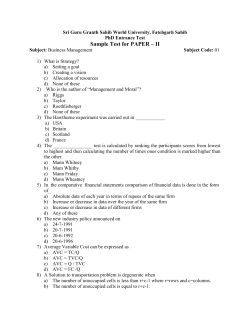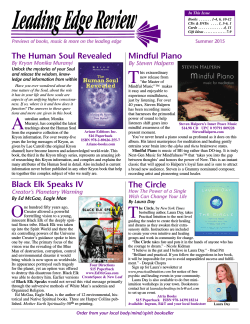
The RMap Project: Linking the Products of Research and Scholarly
The RMap Project: Linking the Products of Research and Scholarly Communication
2015‐04‐22 Tim DiLauro <timmo@jhu.edu>
Motivation
•
Compound objects fast becoming the norm for outputs of scholarly
communication.
•
In many circumstances, the traditional article is not the object of long-term
interest for at least some segment of the community.
•
Components may reside in different repositories, maintained by different
institutions, employing different technologies.
–
•
Some of these components and their repositories are not part of the traditional scholarly
communication ecosystem.
Acknowledgement that these objects do not stand alone -- and of a broad need
to understand their context.
Research Partnership
• Data Conservancy: Expertise in management of large
data archives from multiple disciplines
• IEEE: Expertise in management of data-intensive
scholarly journal publications
• Portico: Expertise in digital preservation, publisher
workflow requirements, and existing relationships with
275 publishers
• Funding from the Alfred P. Sloan Foundation
Some High-Level Goals
• RMap tool working prototype
• Collaborative partnerships with the community
• System that supports emerging forms of digital
scholarship and publishing
• Plan for sustainability of the project
Work Plan
• Year One—Planning Phase: Gather requirements, create
use cases, hold workshop with stakeholders, refine use
scenarios based on community feedback
• [You are here] Year Two—Prototype Development:
Create system to identify, store, update, and retrieve
relationships among publications and other forms of
scholarly output, including data and software
TECHNOLOGY
The RMap Project
Key Objectives
• Support assertions from broad set of contributors
• Integrate with Linked Data
• Leverage data from existing scholarly publishing stakeholders (publishers, identifier providers, data and software repositories)
• Provide support for agents and other resources without identifiers (authors, textual citations)
Data Model (simplified)
Data Model - Resource
• Things (abstract or concrete) that can have an identifier
• Basic building block of the WWW
• Key entity for description and retrieval within RMap
• Other core entities in the data model are also Resources
Data Model - Agent
• A person or thing (or group of these) responsible for some action
• Distinction between scholarly (e.g., author, funder, publisher, data processing program) and system (RMap component, user, etc.)
Data Model - Event
• Capture provenance within RMap system
• An action or activity involving System Agents and other resources
• Provenance of Scholarly Resources can be captured separately by registering it in RMap via DiSCOs.
Data Model – RDF Statement (triple)
• Building blocks of the semantic web
• Conceptually of the form: <subject> <predicate> <object>
• Like subject‐verb‐object in English
Data Model - DiSCO
• Distributed Scholarly Compound Object
• Primary unit of registration within RMap
• Basically a set of resources and related RDF description.
• Similar to OAI‐ORE
Data Model - DiSCO
DiSCO
C-2
Compound
Object
creator
D-1
A-2
cites
S-1
creator
source
D-2
outputOf
Create dataset D-1
Software
Repositories
Data
Repositories
Publishers
C-1
C-1
creator
D-1
creator
D-1
RMap Linked Data Graph
C Creator
A Article
D Dataset
Incoming DiSCO
S Software
Create software S-1
Software
Repositories
Data
Repositories
C-1
C-1
Publishers
creator
S-1
C-1
creator
D-1
creator
S-1
RMap Linked Data Graph
C Creator
A Article
D Dataset
Incoming DiSCO
S Software
Generate dataset D-2
Software
Repositories
Data
Repositories
C-1
C-1
Publishers
creator
creator
outputOf
S-1
D-2
source
creator
C-1
S-1
inputOf
D-1
outputOf
creator
D-2
inputOf
D-1
source
RMap Linked Data Graph
C Creator
A Article
D Dataset
Incoming DiSCO
S Software
Article related to D-2
Software
Repositories
Data
Repositories
C-1
C-1
Publishers
C-1
creator
creator
creator
outputOf
S-1
cites
D-2
source
creator
A-1
creator
cites
inputOf
C-1
D-1
A-1
cites
D-2
cites
D-1
source
RMap Linked Data Graph
C Creator
A Article
D Dataset
Incoming DiSCO
S Software
Creation of software S-2
Software
Repositories
Data
Repositories
C-1
C-1
Publishers
C-1
creator
creator
creator
outputOf
S-1
cites
D-2
source
A-1
creator
cites
inputOf
D-1
C-2
creator
S-2
C-2
creator
S-2
RMap Linked Data Graph
C Creator
A Article
D Dataset
Incoming DiSCO
S Software
Generation of dataset D-3
Software
Repositories
Data
Repositories
C-1
C-1
Publishers
C-1
creator
creator
creator
outputOf
D-2
S-1
source
cites
A-1
creator
cites
inputOf
C-2
D-1
S-2
outputOf
creator
C-2
D-3
inputOf
C-2
D-1
source
creator
source
inputOf
creator
outputOf
S-2
D-3
RMap Linked Data Graph
C Creator
A Article
D Dataset
Incoming DiSCO
S Software
Article A-2 related to D-3
Software
Repositories
Data
Repositories
C-1
C-1
Publishers
C-2
C-1
creator
creator
creator
outputOf
D-2
S-1
source
creator
creator
cites
C-2
cites
cites
A-2
creator
cites
cites
inputOf
D-1
A-2
A-1
cites
cites
D-3
C-2
D-1
source
inputOf
cites
C-2
D-2
creator
source
creator
outputOf
S-2
D-3
RMap Linked Data Graph
C Creator
A Article
D Dataset
Incoming DiSCO
S Software
Correct article identifier
Software
Repositories
Data
Repositories
C-1
C-1
Publishers
C-2
C-1
creator
creator
creator
outputOf
D-2
S-1
source
creator
creator
cites
C-2
cites
cites
A-3
creator
cites
cites
inputOf
D-1
A-3
A-1
cites
cites
D-3
C-2
D-1
source
inputOf
cites
C-2
D-2
creator
source
creator
outputOf
S-2
D-3
RMap Linked Data Graph
C Creator
A Article
D Dataset
Incoming DiSCO
S Software
Dataset D-1 connections
Software
Repositories
Data
Repositories
C-1
C-1
Publishers
C-2
C-1
creator
creator
creator
outputOf
D-2
S-1
source
creator
cites
cites
A-3
A-1
cites
inputOf
D-1
C-2
creator
cites
D-1
cites
?
inputOf
C-2
creator
source
creator
outputOf
S-2
D-3
RMap Linked Data Graph
C Creator
A Article
D Dataset
Perspective
S Software
Creator C-1 connections
Software
Repositories
Data
Repositories
C-1
C-1
Publishers
C-2
C-1
creator
creator
creator
outputOf
D-2
S-1
source
creator
cites
cites
A-3
A-1
cites
inputOf
D-1
C-2
creator
cites
cites
C-1
?
inputOf
C-2
creator
source
creator
outputOf
S-2
D-3
RMap Linked Data Graph
C Creator
A Article
D Dataset
Perspective
S Software
Associate resources with C-1 identity
Software
Repositories
Data
Repositories
C-1
C-1
Identity
Providers
Publishers
C-2
C-1
C-1
creator
creator
creator
outputOf
D-2
S-1
source
creator
creator
creator
cites
cites
cites
A-3
A-1
A-1
cites
inputOf
creator
D-1
cites
D-2
C-2
creator
inputOf
C-2
creator
D-1
creator
source
creator
outputOf
S-2
C Creator
D-3
A Article
S-1
D Dataset
S Software
Associate resources with more identities
Software
Repositories
Data
Repositories
C-1
C-1
Identity
Providers
Publishers
C-2
C-1
C-2
C-1
creator
creator
creator
outputOf
D-2
S-1
source
creator
creator
creator
creator
cites
cites
cites
A-3
A-1
A-1
A-3
cites
inputOf
creator
D-1
cites
creator
D-2
C-2
creator
creator
inputOf
C-2
creator
source
D-3
D-1
creator
creator
outputOf
S-2
C Creator
D-3
A Article
S-1
D Dataset
S Software
S-2
RESTful APIs
• Programming language independent
• Easy to test with web tools (curl, wget)
• Abstraction away from underlying
implementations and models, which we
expect to change more often
REST APIs (subset)
Function
Retrieve related triples
Retrieve related events
Retrieve related DiSCOs
Create DiSCO
Retrieve DiSCO
Update DiSCO
Delete a DiSCO
Retrieve an Event
Get DiSCOs related to event
Perform SPARQL query
HTTP
verb
API rel path (base=/api/{version})
GET
/{resourceURI}/stmts
GET
/{resourceURI}/events
GET
/{resourceURI}/discos
POST
/disco
GET
/disco/{discoId}
POST
/disco/{discoId}/update
DELETE
/disco/{discoId}/delete
GET
/event/{eventId}
GET
/event/{eventId}/discos
POST
/sparql
API Specification and Documentation
Behaviors API paths
Data Models
Serializations (media types, content negotiation)
• Implementations
•
•
•
•
API Description (simplified)
Function: Update DiSCO
•
Behavior within RMap
–
–
–
–
–
–
–
•
Request
–
–
–
–
•
Failed requests will be rolled back, so as not to require manual cleanup (transaction)
Insufficient authorization will result in failed transaction and offer to authenticate with other credentials.
A new DiSCO will be instantiated; the previous (old) DiSCO will be marked “inactive”
Add triple <new‐DiSCO‐URI> <hasVersion> <old‐DiSCO‐URI> Resources will be instantiated for objects without identifiers (e.g., citation as string)
Scholarly Agents will be instantiated for agents lacking URIs (e.g., creator as string)
Event(s) created capture activity
Verb/relative path: POST /disco/{id}/update
Path parameters: {id} ‐ URI of existing (old) DiSCO
Model: Resources + relationships (like OAI‐ORE)
Serializations: RDF/XML, Turtle, or JSON‐LD
Response
–
–
–
–
–
–
Model: (custom)
Serializations: JSON, HTML
New DiSCO URI in header: Location: <new‐DiSCO‐URI>
Old DiSCO URI in header: Link <old‐DiSCO‐URI>;rel=“predecessor‐version”
Event URI(s) in header: Link <event‐URI>;rel=“http://www.w3.org/ns/prov#wasGeneratedBy”
[Enumerate response codes, labels, and their meanings]
API Coverage
• Current focus on APIs to populate and access the graph
• Future focus
–
–
–
–
–
Authentication
Administration
Composition & normalization
Inferencing
System operability
Technical Team Activity
•
•
•
•
Developed and captured initial set of use cases
Developed and documented initial data model
Specified API behaviors
Developed and documented API methods, including REST paths, request and response formats, models, and serializations (media types) – Still a couple issues to sort out
• Prototype platform implementation
• Participation in RDA Data Publishing groups
• Actively working on harvesting relationship data to push into RMap
Harvesting links and proxy registration
RMap
Instance
Register
Register
RMap
Harvester
Publisher
Data
Repository
Harvest
Register
Harvest
Harvest
Data
Repository
Identity
Service
Publisher
Community Engagement
The RMap Project
Workshop: Key Feedback
• RMap Project should be a clearinghouse or meta‐
service that captures information about various data‐linking services
• Important to add value to the publication & data linking work already underway in the community
• Having an established publisher as a research partner is a comparative advantage for the RMap Project
Workshop Feedback (continued)
• One approach would be to focus on the “input” side of the process (with special attention for software and research workflows) in order to create a generalizable approach to gathering content
• The challenge of “secondary data”, such as the inferred connections between publications and data or software remains unaddressed and important
Some of the things you can do for RMap
• Feedback
– Do the articulated use cases, approach, goals, and proposed offerings
align with your interests. Where they don’t, how could we better align?
• Share Your Data
– As we populate our prototype, we need to gather a broad swath of test
data, covering a variety of resource types (e.g., journals, repositories,
funders, creators, articles, data, software, instruments, samples) and the
relationships that connect them.
• Use
– Consider using RMap capabilities to register, discover connections to, and
augment your own content, once those capabilities become available.
Some of the things RMap will do for you
•
Aggregate and offer an inclusive and normalized view of distributed scholarly
compound objects and associated resource relationships, including those from
sources without membership in existing identity services (e.g., source code
management platforms, institutional repositories).
–
•
Provide a single mechanism to discover context (e.g., relationships and related
resources) for scholarly objects in which you are interested.
–
•
•
Reduce cost and complexity of transforming information from multiple systems.
Reduce cost and complexity of developing and managing multiple interfaces for multiple
systems.
Expose records of a particular statement (e.g., who has asserted that Resource
X was created by Agent Y?) or the history of assertions associated with a with a
particular resource (i.e., what has been said about Resource X?).
Capture sufficient provenance information to allow evaluation of assertions by
their source and content.
–
Streamline logic for automatic integration of citation and reference to objects of interest.
Team Members and Acknowledgements
•
Sayeed Choudhury, Tim DiLauro: Data Conservancy, Johns Hopkins
•
Mark Donoghue, Gerry Grenier, Renny Guida, Ken Rawson: IEEE
•
Vinay Cheruku, Karen Hanson, Amy Kirchhoff, John Meyer, Sheila
Morrissey, Stephanie Orphan, Jabin White, Kate Wittenberg: Portico
This research project is made possible through generous support
from the Alfred P. Sloan Foundation
We thank our workshop participants for their valuable feedback
Q&A
• For more information, please visit:
– http://rmap-project.info/rmap/
© Copyright 2025









